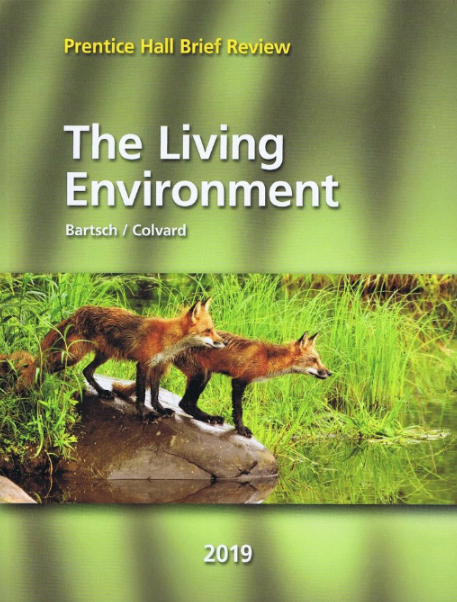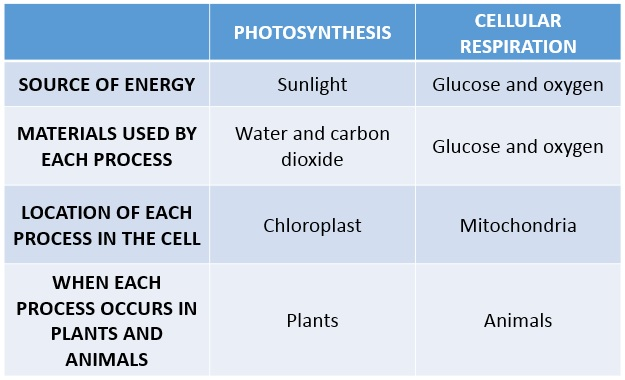
Prentice Hall Brief Review: The Living Environment 2019
ISBN: 9781418292164
Textbook solutions
All Solutions
Section 2.1: Basic Biochemical Processes of Living Organisms
Exercise 1
Step 1
1 of 2
The answer is 4. Chloroplast is the one responsible for producing food for the plant cell. It is considered as one of the parts that are essential to the cell.
Result
2 of 2
4
Exercise 2
Step 1
1 of 2
The answer is 2. Photosynthesis is defined as the process wherein producers such as plants or algae produce their food using the sun’s energy by converting it into carbohydrates.
Result
2 of 2
2
Exercise 3
Step 1
1 of 2
The answer is 4. Carbon dioxide, the time of the day and the number of chloroplasts are important in the process of photosynthesis. carbon dioxide is one of the major reactants, the time of the day since sunlight is a major factor and chloroplasts, which is the one responsible for the nutrients.
Result
2 of 2
4
Exercise 4
Result
1 of 1
Photosynthesis is defined as the process wherein producers such as plants or algae produce their food using the sun’s energy by converting it into carbohydrates. Water and carbon dioxide are the reactants of photosynthesis.
Exercise 5
Step 1
1 of 2
The answer is 2. Photosynthesis is defined as the process wherein producers such as plants or algae produce their food or sugar using the sun’s energy by converting it into carbohydrates.
Result
2 of 2
2
Exercise 6
Step 1
1 of 2
The answer is 2. Photosynthesis is defined as the process wherein producers such as plants or algae produce their food using the sun’s energy by converting it into carbohydrates. Carbon dioxide is one of the reactants in photosynthesis.
Result
2 of 2
2
Exercise 7
Step 1
1 of 2
The answer is 4. Photosynthesis is the process of generating energy from sunlight and storing them as chemical energy for future use. It is commonly used by plants as their source of energy.
Result
2 of 2
4
Exercise 8
Result
1 of 1
1) Two raw materials plants use in photosynthesis include water and carbon dioxide.
2) These raw materials are the reactants of photosynthesis with a product of glucose and oxygen.
2) These raw materials are the reactants of photosynthesis with a product of glucose and oxygen.
Exercise 9
Result
1 of 1
Chemical bond energy is a type of bond between two molecules. This chemical bond can either be ionic or covalent.
Exercise 10
Step 1
1 of 2
The answer is 2. Cellular respiration is the process wherein energy from nutrients are converted into ATP for usage of cells. This is also the process of transferring chemical bond energy to energy called ATP.
Result
2 of 2
2
Exercise 11
Step 1
1 of 2
The answer is 1. By way of cellular respiration, glucose is used to create energy molecules and this type of energy is called ATP. This ATP is used for obtaining, transforming and transporting to eliminating wastes.
Result
2 of 2
1
Exercise 12
Step 1
1 of 2
The answer is 1. Cellular respiration is the process wherein energy from digested nutrients are converted into ATP for usage of cells.
Result
2 of 2
1
Exercise 13
Step 1
1 of 2
The answer is 3. This process is called cellular respiration. Cellular respiration is the process wherein energy from nutrients are converted into ATP for usage of cells.
Result
2 of 2
3
Exercise 14
Step 1
1 of 2
The answer is 2. Cellular respiration is the process wherein energy from nutrients are converted into ATP for usage of cells. This process involves glycolysis, krebs cycle and the electron transport chain.
Result
2 of 2
2
Exercise 15
Step 1
1 of 2
The answer is 1. ATP is an energy-carrying molecule for the use of cells. Another form of ATP is ADP which is without a phosphate end and can reattach to another phosphate to produce another ATP.
Result
2 of 2
1
Exercise 16
Step 1
1 of 2
The answer is 2. Energy is released for metabolic processes. Once energy is released, it is converted to ADP which then in return, can attach to another phosphate in order to form another ATP.
Result
2 of 2
2
Exercise 17
Step 1
1 of 2

Result
2 of 2
Photosynthesis vs. cellular respiration
Exercise 18
Step 1
1 of 2
The answer is 4. This process is called cellular respiration. Cellular respiration is the process wherein energy from nutrients are converted into ATP for usage of cells. Number 1 and 2 is the process of photosynthesis.
Result
2 of 2
4
Exercise 19
Result
1 of 1
Yes, photosynthesis and cellular respiration can occur at the same time but only cellular respiration occur at night time. Photosynthesis cannot occur during the night because sunlight is needed in order for this process to occur.
Exercise 20
Step 1
1 of 2
The answer is 1. This is a diagram of a mitochondria or the powerhouse of the cell. What happens is that nutrients digested by the cell are converted into stored energy to be used in various processes needed by the cell.
Result
2 of 2
1
Exercise 21
Step 1
1 of 2
The answer is 1. ATP is an energy-carrying molecule for the use of cells. Another form of ATP is ADP which is without a phosphate end and can reattach to another phosphate to produce another ATP.
Result
2 of 2
1
Exercise 22
Step 1
1 of 2
Th answer is 1. Enzymes are natural forms of molecules which function to increase the processing of chemical reactions seen inside cells. Most of these enzymes are proteins and are important in using certain reactions.
Result
2 of 2
1
Exercise 23
Step 1
1 of 2
The answer is 2. Enzymes are often reused or recycled so that it can be used again. This is done when an enzyme binds to a substrate and a reaction is produced, the enzyme is released again, not even changing its form or contents so that it can be used again.
Result
2 of 2
2
Exercise 24
Step 1
1 of 2
The answer is 4. The endoplasmic reticulum is needed in the making or production of protein and lipid molecules which are either secreted or used up again for producing a new endoplasmic reticulum. They also function in the folding of proteins molecules and in delivering manufactured proteins in vesicles to the golgi apparatus.
Result
2 of 2
4
Exercise 25
Step 1
1 of 2
The answer is 3. This enzyme controlled reactions involves a series of reactions needed to survive. Examples of these reactions include growth, digestion, respiration, excretion and regulation.
Result
2 of 2
3
Exercise 26
Step 1
1 of 2
The answer is 1. Enzymes come from proteins and proteins come from ribosomes which are attached to the endoplasmic reticulum. The endoplasmic reticulum is the main organelle for processing enzymes.
Result
2 of 2
1
Exercise 27
Step 1
1 of 2
The answer is 3. Enzymes are natural forms of molecules which function to increase the processing of chemical reactions seen inside cells. Most of these enzymes are proteins and are important in using certain reactions.
Result
2 of 2
3
Exercise 28
Step 1
1 of 2
The answer is 1. The concentration of sugar molecules can increase the activity of enzymes as early as the reaction is beginning. This is because it is directly proportion to the substrate. An increase in enzyme concentration will also increase the substrate concentration
Result
2 of 2
1
Exercise 29
Step 1
1 of 2
The answer is 4. As seen in the graph we can notice that as the temperature increases upto 38 degrees, the rate of an enzyme action also increases. But, as we increase the temperature a little bit more, the rate of enzyme action decreases.
Result
2 of 2
4
Exercise 30
Step 1
1 of 2
The answer is 2. The meaning of being chemically specific means that a certain enzyme does not act on other substrate not specific for its shape. It is like a lock and key principle that only the right key or enzyme can be compatible with the lock or substrate.
Result
2 of 2
2
Exercise 31
Step 1
1 of 2
The answer is 2. As we can see in the graph, in 70 to 80 degrees, no reactions were seen. From 10 to 30, the reaction was seen to be gradually increasing, from 40 to 50 degrees, the maximum reaction was seen and from 50 to 70 degrees, there was a decrease in reaction.
Result
2 of 2
2
Exercise 32
Step 1
1 of 2
The answer is 3. When a reaction rapidly occurs, this can either cause a positive or negative effect on the organism. An increase in reaction may be due to a lot of factors like increasing the temperature or increasing the amount of substrate and vice versa.
Result
2 of 2
3
Exercise 33
Step 1
1 of 2
The answer is 3. In this diagram, the X indicates the enzyme, the substrate is the one connecting to the active site of the enzyme to activate it and create a reaction.
Result
2 of 2
3
Exercise 34
Result
1 of 1
This is called the enzyme controlled reaction. What happens here in step 1 is that there is binding of the enzyme(A) and substrate(B) in the enzymes active site, in step 2 the substrate enzyme complex(C) is formed and produces a reaction which is cleaving and in step 3 the release of products are seen both (E) and (D).
Exercise 35
Result
1 of 1
This reaction is an illustration of synthesis. as we can see in step 3 there was a cleavage of the substrate(B) creating two other products instead of just one.
Exercise 36
Result
1 of 1
Heating of these molecules slows down the rate of the reaction becuase some proteins in the enzyme become denatured when heated thus losing properties which make them active.
Exercise 37
Step 1
1 of 2
The answer is 3. The independent variable in this data is temperature because the amount of digestion would be based on the temperature given.
Result
2 of 2
3
Exercise 38
Step 1
1 of 2
The answer is 2. According to the data given, at a temperature of 8 to 21 degrees, the amount of digestion in mm after 48 hours is 2.5 to 4.0 thus, at a temperature of 15 degrees, the amount digestion in mm can be between 2.5 to 4.0.
Result
2 of 2
2
Exercise 39
Step 1
1 of 2
The answer is 3. The amount of digestion produced depends on the degree of temperature applied on the gastric fluid.
Result
2 of 2
3
Exercise 40
Result
1 of 1
There was no reaction because the enzyme was specific for only the egg white. Enzymes can be specific with its substrate which is illustrated by the lock and key mechanism.
Exercise 41
Result
1 of 1
Fish eat very little during the winter because during the winter some reactions such as digestion can be slowed down also. The enzymatic reactions are slowed down thus, food is not digested quickly.
unlock

